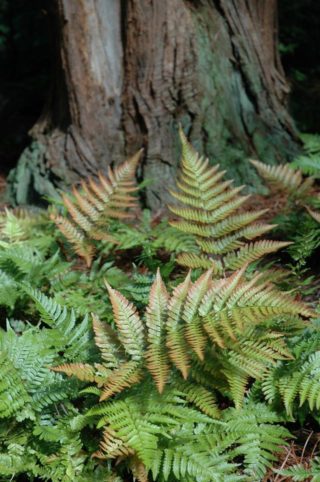Fabulous perennial ferns add texture and contrast to any shade garden.
Their names are complicated and there are many different varieties – but don’t let that scare you!
I”m pretty comfortable with annuals and many perennials but when it comes to ferns, I still have a lot to learn. The good news is that most of the ferns we offer are pretty easy to grow. The hardest part seems to be deciding what type of ferns will work best for your area. Ferns come in a variety of textures, colors and habits.
Ferns have been around a long time. The articles I have read said fossils have been found from over 360 million years ago. I know ferns are certainly in Jurassic Park! Ferns are leafy, non-flowering plants that really like to grow in moist and shady conditions. The reproductive cycle for ferns is more complicated than most of the plants that I am familiar with but that’s ok because dividing them is easy and many spread easily so no need to take cuttings.
Dividing Ferns – It’s something even I can do! Dig up the fern and remove some of the extra soil. Using a long, sharp blade, split the fern into halves or quarters depending on the size plant you are starting with and the size plant you want to end up with. Ferns are pretty tough so you might need to apply a little extra force. After planting into a new area, make sure to keep them well watered to get started.
Types of Ferns –
- Athyrium – Lady Ferns are clump forming which means they won’t take over your garden. Lady ferns also make great houseplants. As a matter of fact, Lady Ferns were one of the most popular plants in the Victorian Era. Lady ferns grow in the wild in North America especially in forests. They like shady, moist conditions and are very hardy.
- Dryopteris – Wood Ferns are clump forming and some are evergreen
- Matteucea – Ostrich Ferns are colonizing and migrate nicely. Some may migrate more than you really want them to. so be careful where you plant them.
- Onoclea “Sensitive Fern” and “Osmunda” – do well in sun. Royal Ferns like moist conditions; great for water ponds. They generally get quite tall (up to 4 ft). The name Sensitive Fern comes about because they are more sensitive to the cold than others.
The different textures and colors of ferns make them interesting. One of the biggest benefits for me is the fact that deer just ignore them. They eat a lot of my other flowers but leave the ferns alone.


